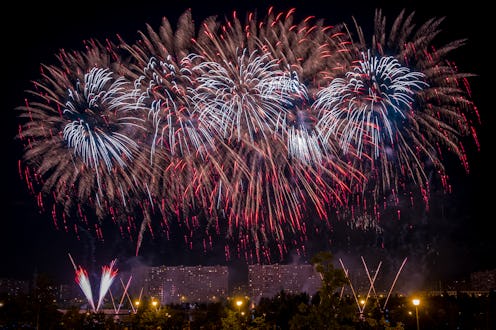
The Jul. 4 is coming up, and that means one thing — fireworks. While you've probably witnessed a fireworks display before, there are a few weird facts about fireworks that you might not have realized. Obviously a lot goes into making the presentation an enjoyable one, but they've got such science and history about them that they're worth exploring a bit further.
Traditionally, fireworks are made out of gunpowder, but there are other chemicals involved to help give off the effect you see on major holidays. When you go up on the roof to get the best view of the colorful display, it's actually a chemical reaction you're seeing. Of course, that's part of the reason why the displays are left up to the professionals. Since they're categorized as explosives, it's usually the job of a pyrotechnic engineer to make sure things go off pretty smoothly.
Science aside, fireworks are also a work of art. There are a ton of different types of fireworks that help keep things lively. Skyrockets are the type of fireworks that you see high in the sky, while pinwheels usually explode a little bit lower. And then of course, there are fireworks that are more about the sound than the display. Those are known best as firecrackers.
Here are a few fun, yet strange facts about fireworks that'll help you appreciate the holiday even more.
1Fireworks Can Be Linked To Air Pollution
It's pretty obvious that fireworks aren't the greatest for the environment, which is probably why we only see them on special occasions. According to the Smithsonian, they cause a lot of air pollution — and also release heavy metals when they go off. They've also been linked to thyroid and lung issues, so if you can, make sure you enjoy the show from a safe distance.
2Fireworks Were Outlawed In Rhode Island In The 1700s
Why? Because there were too many firework-related shenanigans happening. While we all know that we shouldn't mess with fireworks, that was a lesson that many people learned the hard way back in in 1731.
3Italy Is Responsible For Fireworks Having Different Colors
Even though fireworks were invented in China, it was Italy that took things to the next level. Based on burning different metallic powders, new effects were born. For example, sodium helps create yellow fireworks. If you're a fan of green fireworks, you can thank barium for that.
4Fireworks Create Three Different Types Of Energies
During a show, you might realize that there are three different types of energy at play — light, heat, and sound. In fact, the boom of a firework is created by the quick release of energy. Going to a display must be a dream field trip for the science teacher in your life.
5King Henry VII's Wedding Had The First Recorded Fireworks Display
King Henry VII's wedding, which took place in 1486, symbolically joined together the House of York and the House of Lancaster, thus ending the "War of the Roses." So, if any wedding should be highly celebrated with fireworks, it was probably his.
6The Toughest Color Fireworks To Create Is Blue
You've probably seen blue fireworks before — but, they likely weren't as blue as they could have been. Blue is created by using copper, but the temperature needs to be absolutely perfect in order for the firework to truly shine. Bright blue fireworks are somewhat of a rarity. If you see one, just know that a lot of time and effort went into creating it.
7The Largest Fireworks Display In History Was In The Philippines
The record changes every so often, but currently, the Philippines takes on the title for a 2016 New Year's show that incorporated 810,904 fireworks. The show lasted just over an hour. In the United States, a display called “Thunder Over Louisville” which happens at the Kentucky Derby is considered to be the largest, attracting about half a million people.
8Sparklers Are Basically Equal To A Blow Torch
While you might not think of sparklers when you think of fireworks, they still count. And not to be a killjoy, but they also have an element of danger. In 2014, about 31 percent of firework-related injuries were caused by sparklers, which is weirdly high. In fact, the The Consumer Product Safety Commission claims that sparklers are just about equal to a blow torch in terms of heat and danger.